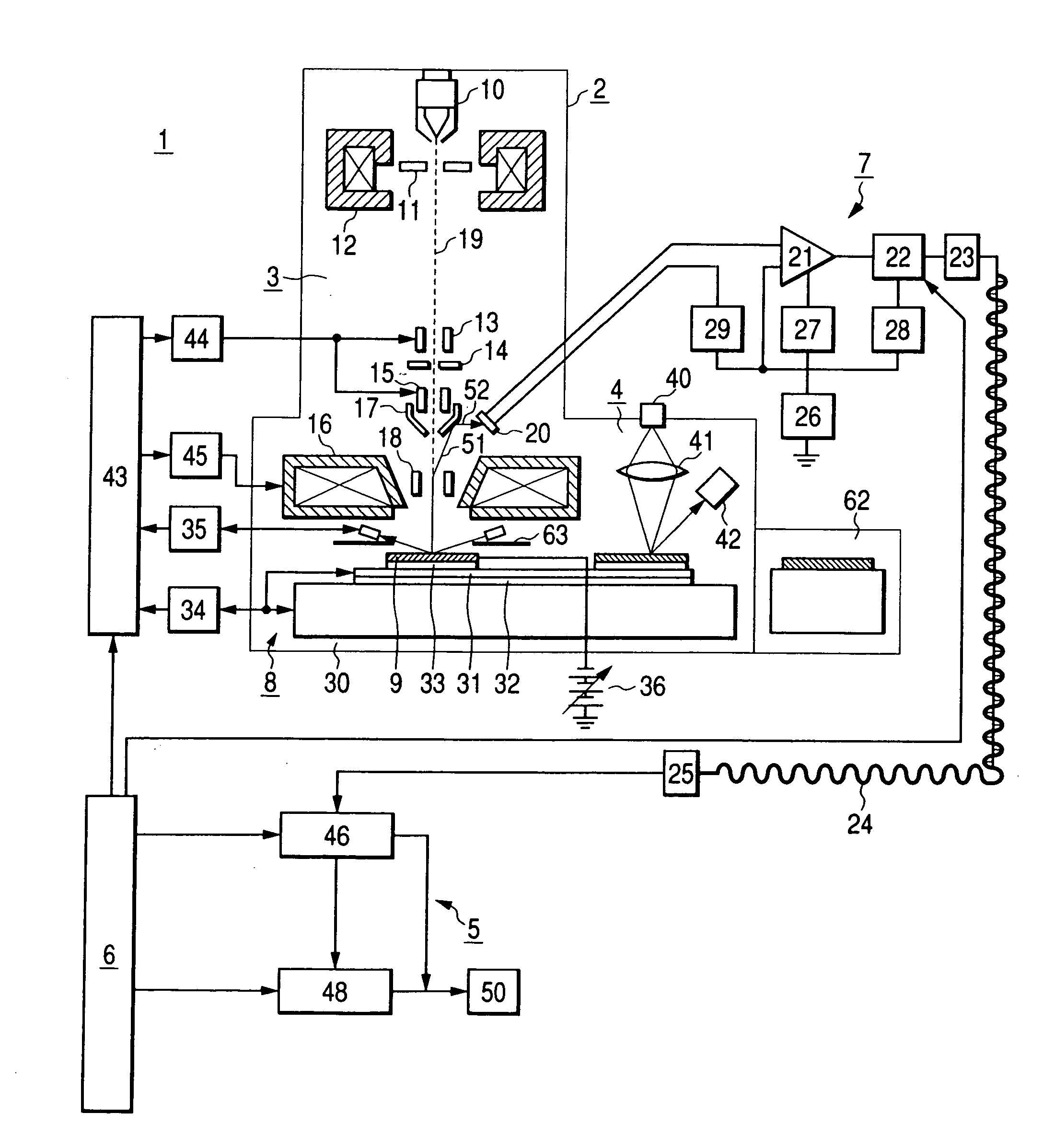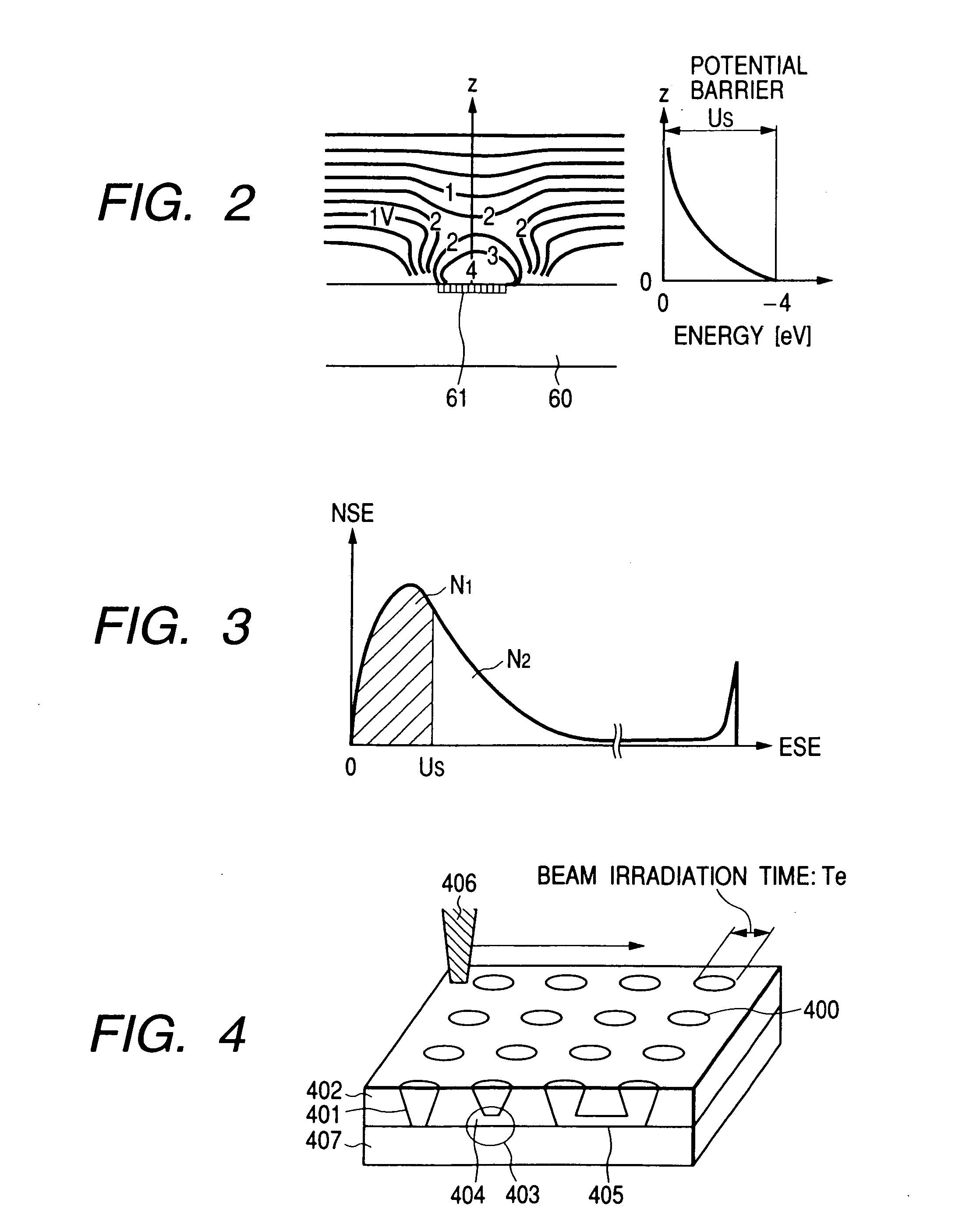Inspection method and inspection system using charged particle beam
a technology of inspection system and charged particle, which is applied in the direction of semiconductor/solid-state device testing/measurement, image enhancement, instruments, etc., can solve the problems of unrealistic method, difficult measurement, and soft tip, and achieve the effect of short time only
- Summary
- Abstract
- Description
- Claims
- Application Information
AI Technical Summary
Benefits of technology
Problems solved by technology
Method used
Image
Examples
first embodiment
[0059]FIG. 1 shows the configuration of an inspection system as a first embodiment of the invention. The inspection system 1 has an inspection chamber 2 evacuated to be in a vacuum, and a spare chamber (not shown in this embodiment) for carrying a wafer 9 to be inspected into the inspection chamber 2. The spare chamber can be evacuated independent of the inspection chamber 2. The inspection system 1 has, other than the inspection chamber 2 and the spare chamber, a control unit 6 and an image processing unit 5. The inspection chamber 2 has therein, broadly, electron optics 3, a detector 7, a sample chamber 8, and an optical microscope unit 4.
[0060] The electron optics 3 include an electron gun 10, an electron beam extraction electrode 11, a condenser lens 12, a blanking deflector 13, a scanning deflector 15, an aperture 14, an objective lens 16, a converter electrode 17, and an EXB deflector 18. In the detector 7, a detector 20 is disposed above the objective lens 16 in the inspecti...
second embodiment
[0085] In a second embodiment, the electron beam image is acquired by using the inspection system described in the first embodiment and stored in the image memory unit 46. Images of neighboring equivalent circuit patterns are compared with each other by the calculator 48. When a differential signal level is higher than a predetermined value, the portion in the electron beam image is recognized as a defective portion and is displayed. Since the system has been described in detail in the first embodiment, the description will not be repeated. From the image signal level in the defective position, the electric resistance and capacity are calculated by the calculator 48. The degree of difference in resistance or capacity of the defective portion from the normal portion is obtained. There are the following three methods of obtaining an image of the defective portion.
[0086] In a first method, an inspection of comparing the images with each other is conducted. After completion of the insp...
third embodiment
[0091] A third embodiment relates to an inspection method and inspection system for detecting, as a defect, a circuit pattern having resistance different from a predetermined resistance, which is derived from the brightness of an image by obtaining an electron beam image, and simultaneously comparing the brightness of the image in the circuit pattern position with predetermined brightness by using the inspection system described in the first embodiment.
[0092] First, in FIG. 18, a wafer 181 to be inspected is loaded into the inspection system, and pre-registered electron beam irradiation parameters and signal detection parameters are set. On a sample holder 180, a standard sample 182 of which resistance under predetermined electron beam parameters is preliminarily calculated is attached. Before starting the inspection, an image of the standard sample 182 is acquired, and the correspondence between the resistance and capacity and the electron beam image signal level is calibrated.
[0...
PUM
| Property | Measurement | Unit |
|---|---|---|
| incident energy EPE | aaaaa | aaaaa |
| energy | aaaaa | aaaaa |
| potential barrier | aaaaa | aaaaa |
Abstract
Description
Claims
Application Information
 Login to View More
Login to View More - R&D
- Intellectual Property
- Life Sciences
- Materials
- Tech Scout
- Unparalleled Data Quality
- Higher Quality Content
- 60% Fewer Hallucinations
Browse by: Latest US Patents, China's latest patents, Technical Efficacy Thesaurus, Application Domain, Technology Topic, Popular Technical Reports.
© 2025 PatSnap. All rights reserved.Legal|Privacy policy|Modern Slavery Act Transparency Statement|Sitemap|About US| Contact US: help@patsnap.com



